Design and Experiments of a Roll-Knife Pickup for a Buckwheat Pickup Harvester
Abstract
:1. Introduction
2. Materials and Methods
2.1. Multi-Stage Roll-Knife Pickup Conveyor Process
2.2. Overall Structure and Working Principle of the Roll-Knife Buckwheat Pickup
2.3. Design of the Roll-Knife Pickup Roller
2.3.1. Structure of the Roll-Knife Pickup Roller
2.3.2. Kinematic Model of the Pickup Knife Roller
2.3.3. Simulation Analysis of the Roll-Knife Edge Motion Trajectory
2.3.4. Determination of Parameters for the Pickup Knife Roller
- Force Analysis During Throwing
- Force Analysis During Throwing
2.4. Field Performance Test
2.4.1. Test Materials
2.4.2. Test Preparation
2.4.3. Test Method
2.4.4. Evaluation Criteria
2.4.5. Experimental Design
3. Results and Discussion
3.1. Analysis of Experimental Results
3.2. Establishment and Analysis of the Pickup Loss Rate Model
3.3. Influence of Speed Ratio on Pickup Loss Rate
3.4. Analysis of Working Parameters
3.5. Verification Test
3.6. Discussion
4. Conclusions
Author Contributions
Funding
Data Availability Statement
Conflicts of Interest
References
- Ren, C.; Shan, F.; Wang, M.; Li, Y. Review on Nutrition and Functionality and Food Product Development of Buckwheat. J. Chin. Cereals Oils Assoc. 2022, 37, 261–269. [Google Scholar] [CrossRef]
- Khan, J.; Gul, P.; Liu, K. Grains in a Modern Time: A Comprehensive Review of Compositions and Understanding Their Role in Type 2 Diabetes and Cancer. Foods 2024, 13, 2112. [Google Scholar] [CrossRef]
- Lee, L.-C.; Hou, Y.-C.; Hsieh, Y.-Y.; Chen, Y.-H.; Shen, Y.-C.; Lee, I.J.; Shih, M.-C.M.; Hou, W.-C.; Liu, H.-K. Dietary supplementation of rutin and rutin-rich buckwheat elevates endogenous glucagon-like peptide 1 levels to facilitate glycemic control in type 2 diabetic mice. J. Funct. Foods 2021, 85, 104653. [Google Scholar] [CrossRef]
- Noda, T.; Ishiguro, K.; Suzuki, T.; Morishita, T. Tartary Buckwheat Bran: A Review of Its Chemical Composition, Processing Methods and Food Uses. Plants 2023, 12, 1965. [Google Scholar] [CrossRef] [PubMed]
- Wen, W.; Li, Z.; Shao, J.; Tang, Y.; Zhao, Z.; Yang, J.; Ding, M.; Zhu, X.; Zhou, M. The Distribution and Sustainable Utilization of Buckwheat Resources under Climate Change in China. Plants 2021, 10, 2081. [Google Scholar] [CrossRef]
- Ren, C.; Cui, L.; He, F.; Ouyang, S.; Hu, X.; Li, Z.; Shan, F. Development and Construction of the Oat and Buckwheat Industry Technology System in China. J. Jilin Agric. Univ. 2018, 40, 524–532. [Google Scholar] [CrossRef]
- Liu, M. The Growth Habits and High-Yield Cultivation Techniques of Buckwheat. Hebei Agric. Mach. 2024, 8, 100–102. [Google Scholar] [CrossRef]
- Muraoka, R.; Chien, H.; Zhao, M. Production and Market Participation of Buckwheat Farmers: Micro-Evidence from Shaanxi Province, China. Sustainability 2023, 15, 4822. [Google Scholar] [CrossRef]
- Lu, Q.; Zheng, D.; Liu, Y.; Li, L.; Xu, B.; Ye, S. Problems and Considerations for the Mechanized Harvesting of Buckwheat in China. Agric. Eng. 2020, 10, 6–9. [Google Scholar]
- Cheng, T.; Wang, Q.; Ma, C.; Gan, Z.; Wan, Y.; Ye, X.; Liu, C.; Zou, X.; Zhang, J.; Guo, Y.; et al. Study on the Growth Dynamics of Tartary Buckwheat Flowers and Grains, as Well as Material Basis and Physiological Changes of Their Seed-Setting Differences. Agronomy 2024, 14, 49. [Google Scholar] [CrossRef]
- Huang, X.; Zhang, W.; Dang, W.; Zhang, K.; Feng, S.; Liu, Z.; Yang, F. Research Status and Development Trends of Buckwheat Harvesting Machinery. Agric. Mach. 2018, 10, 84–90. [Google Scholar] [CrossRef]
- Wang, X. Recent Developments and Suggestions for the Full-Mechanization Technology of Buckwheat Production in Shanxi Province. Agric. Technol. Equip. 2022, 3, 44–46. [Google Scholar]
- Hussain, S.; Zheng, D.; Song, H.; Farid, M.U.; Ghafoor, A.; Ba, X.; Wang, H.; Wang, W.; Sher, A.; Alshamali, S.J. Computational fluid dynamics simulation and optimisation of the threshing unit of buckwheat thresher for effective cleaning of the cleaning chamber. J. Agric. Eng. 2022, 53, 1230. [Google Scholar] [CrossRef]
- Huang, X.; Zhang, W.; Zhang, K.; Feng, S.; Liu, Z.; Yang, F. Experimental Study on the Cutting Flow-Horizontal Axial Flow Dual-Roller Threshing of Buckwheat. Res. Agric. Mech. 2023, 45, 183–190. [Google Scholar] [CrossRef]
- Sinkovic, L.; Pipan, B.; Neji, M.; Rakszegi, M.; Meglic, V. Influence of Hulling, Cleaning and Brushing/Polishing of (Pseudo)Cereal Grains on Compositional Characteristics. Foods 2023, 12, 2452. [Google Scholar] [CrossRef]
- Aitkin, D.J.W. Early Growth and Yield Response to Various Two-Stage Tending and Harvesting Treatments; National Library of Canada: Ottawa, ON, Canada, 2003. [Google Scholar]
- Wang, S.; Hu, Z.; Yao, L.; Peng, B.; Wang, B.; Wang, Y. Simulation and parameter optimisation of pickup device for full-feed peanut combine harvester. Comput. Electron. Agric. 2022, 192, 106602. [Google Scholar] [CrossRef]
- Wang, B.; Gu, F.; Cao, M.; Xie, H.; Wu, F.; Peng, B.; Hu, Z. Analysis and Evaluation of the Influence of Different Drum Forms of Peanut Harvester on Pod-Pickup Quality. Agriculture 2022, 12, 769. [Google Scholar] [CrossRef]
- Zhang, L.; Zhang, N.; Meng, Y.; Bao, S.; Guo, X.; Wang, C. Design and Experimental Study of a Pickup Conveyor Hay Collector. Chin. J. Agric. Mech. 2021, 42, 1–6. [Google Scholar] [CrossRef]
- Zhai, G.; Bao, S.; Li, F.; Wang, Z.; Zhang, P. Analysis of Domestic and Foreign Hay Raking Technologies and Typical Equipment. Chin. J. Agric. Mech. 2016, 37, 198–202. [Google Scholar] [CrossRef]
- Chen, Y.; Wang, G.; Wang, J.; Zhang, P.; Wang, B.; Hu, Z. Adaptabilities of different harvesters to peanut plants after cutting stalks. Int. J. Agric. Biol. Eng. 2022, 15, 93–101. [Google Scholar] [CrossRef]
- Jiang, T.; Liang, S.; Jin, M.; Tang, Q.; Wu, C. Performance Comparison Test Study of Toothed Belt and Spring-Tooth Drum Pick-up Units. Res. Agric. Mech. 2018, 40, 171–175. [Google Scholar] [CrossRef]
- Wang, Q. Design and Experimental Study of a Toothed-Belt Buckwheat Pickup Test Platform. Master’s Thesis, Northwest A&F University, Xi’an, China, 2018. [Google Scholar]
- Wang, C.; Zhang, W.; Zhang, Y.; Ding, H.; Feng, S.; Yang, F. Design and Experimental Study of a Scraper-Type Buckwheat Pickup Device. J. Southwest Univ. 2023, 45, 157–166. [Google Scholar] [CrossRef]
- Zhang, K. Study on the Overall Layout and Dynamics Simulation of Buckwheat Pickup Harvester. Master’s Thesis, Northwest A&F University, Xi’an, China, 2019. [Google Scholar]
- Lee, K.Y.; Yoo, S.; Han, B.H.; Choi, Y.; Choi, I.S. Design and Construction of a Pick-up Type Pulse Crop Harvester. J. Biosyst. Eng. 2017, 42, 12–22. [Google Scholar] [CrossRef]
- Shu, C.; Cao, S.; Liao, Y.; Liao, Q.; Wan, X.; Li, Y. Parameter Optimization and Experiment of the Forward Lateral Spreading Device for Rapeseed Swathing Machine Based on ADAMS. Trans. Chin. Soc. Agric. Mach. 2022, 53, 11–19+38. [Google Scholar]
- Ran, J.; Hu, C.; Guo, W.; Wang, X. Design of Key Components for a New Rapeseed Windrower. Eng. Agric. 2024, 44, e20230088. [Google Scholar] [CrossRef]
- Fan, R. Study on the Kinetic Characteristics of Threshing and Cleaning for Buckwheat Harvesting Machinery. Ph.D. Thesis, Shanxi Agricultural University, Jinzhong, China, 2022. [Google Scholar]
- DB 14/T 2079-2020; Technical Specifications for Buckwheat Combine Harvester Operations. Shanxi Provincial Administration for Market Regulation: Taiyuan, China, 2020.
- Li, T. Study on the Performance of Buckwheat Production under Different Sowing Methods in Rainfed Land. Master’s Thesis, Northwest A&F University, Xi’an, China, 2017. [Google Scholar]
- Wang, J. Evaluation of Buckwheat Ecological Adaptability in the Loess Plateau Region. Master’s Thesis, Northwest A&F University, Xi’an, China, 2023. [Google Scholar]
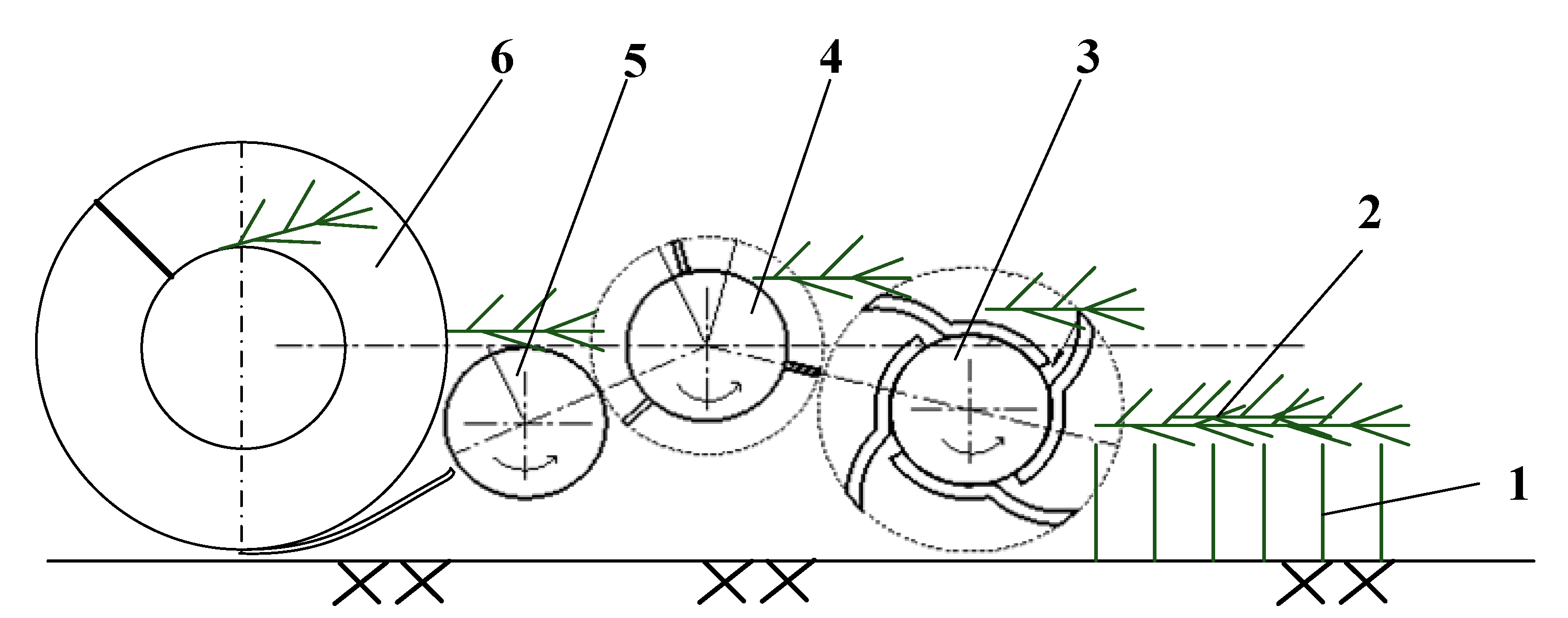


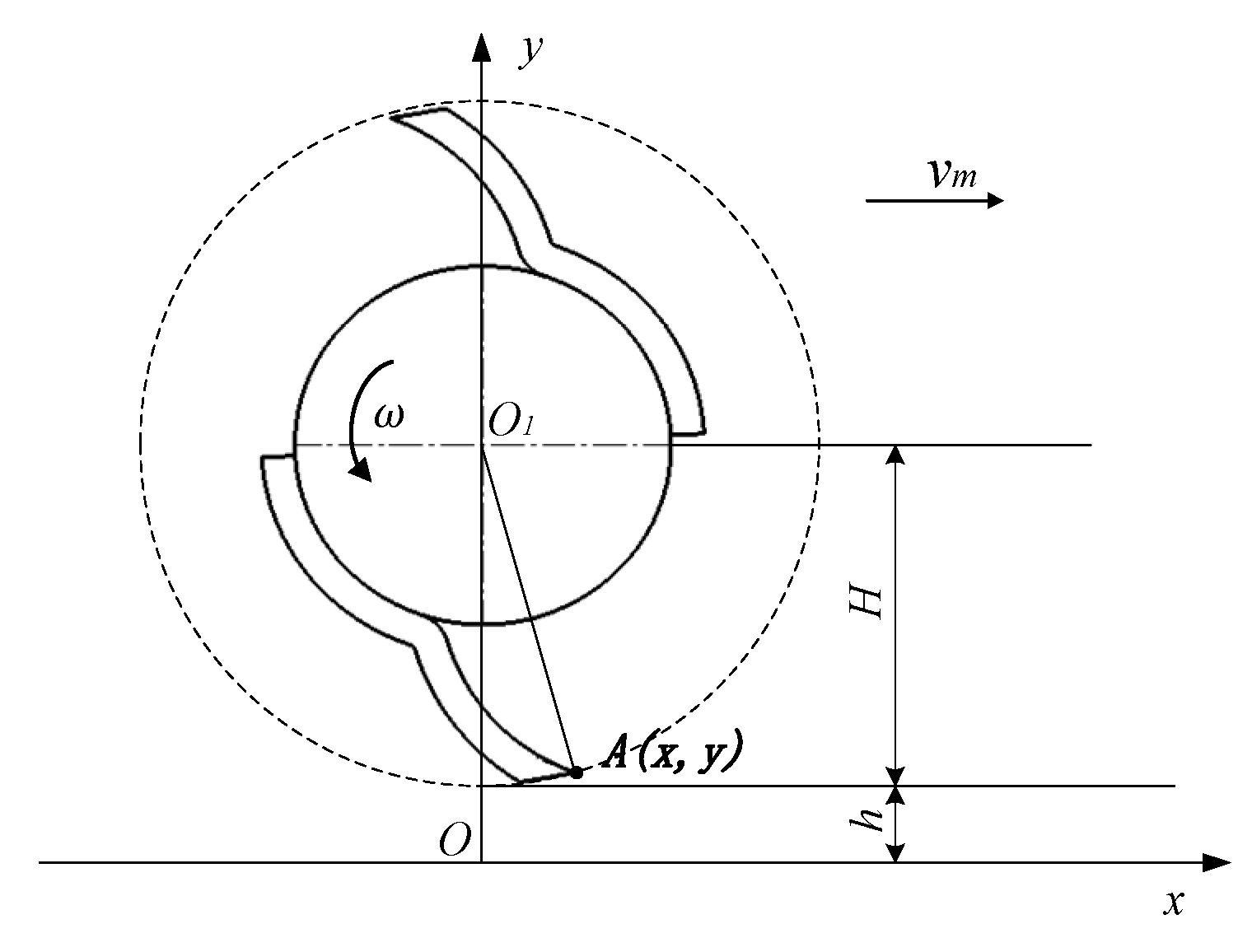
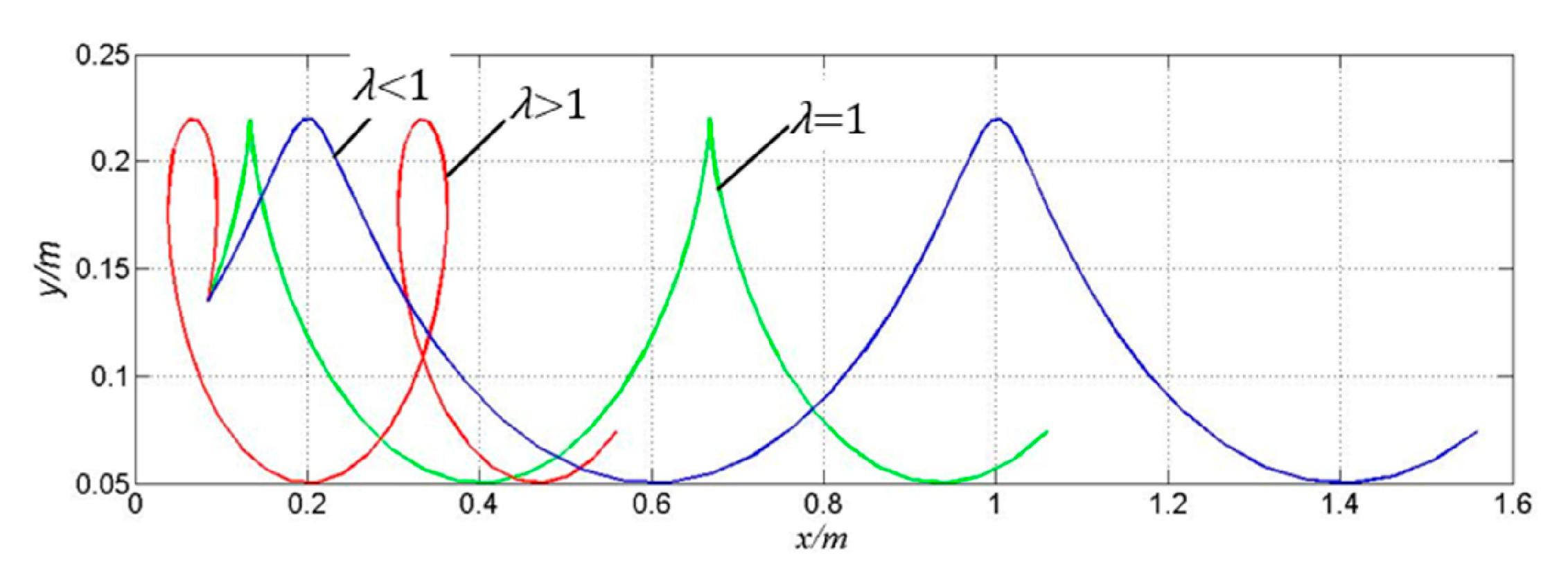
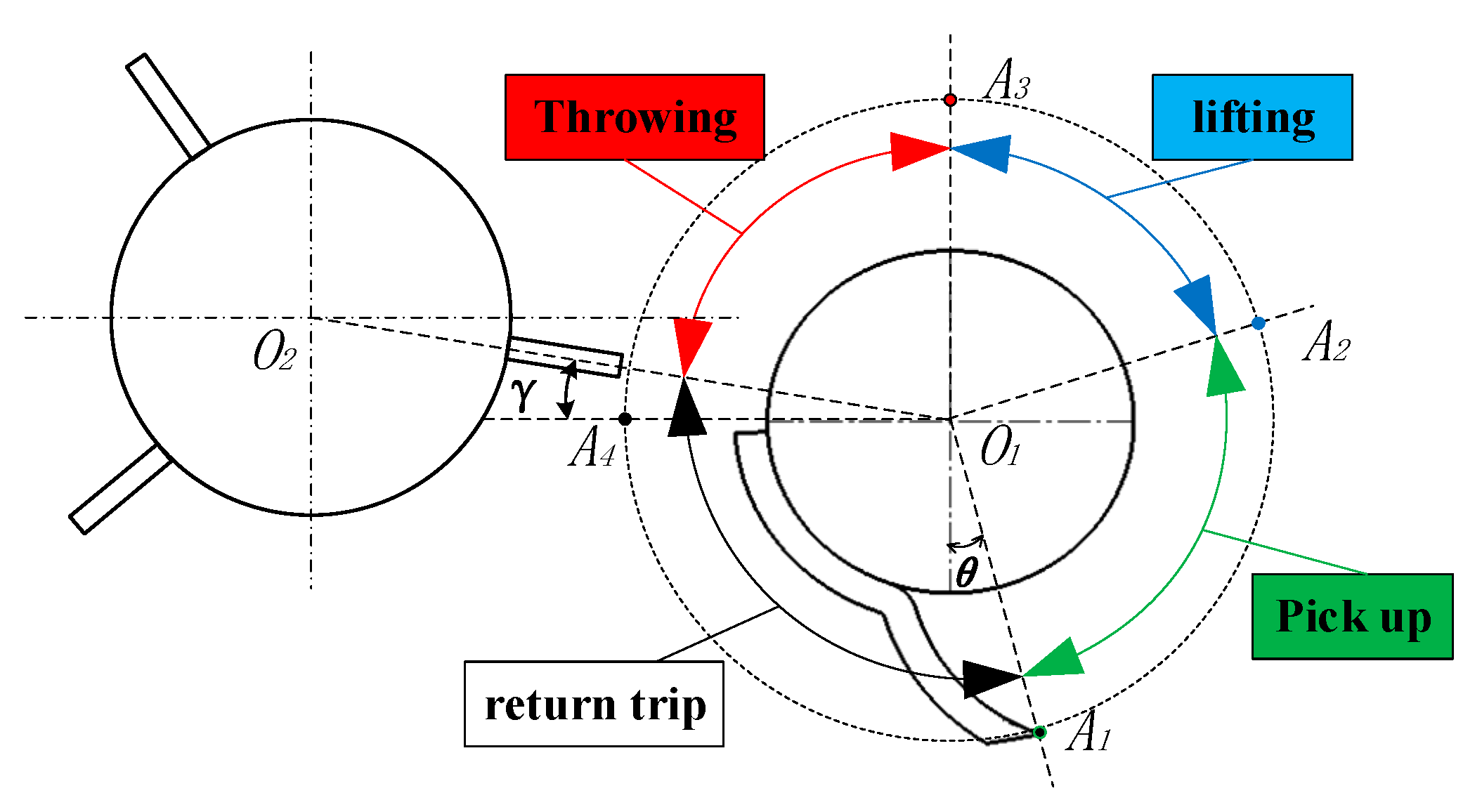
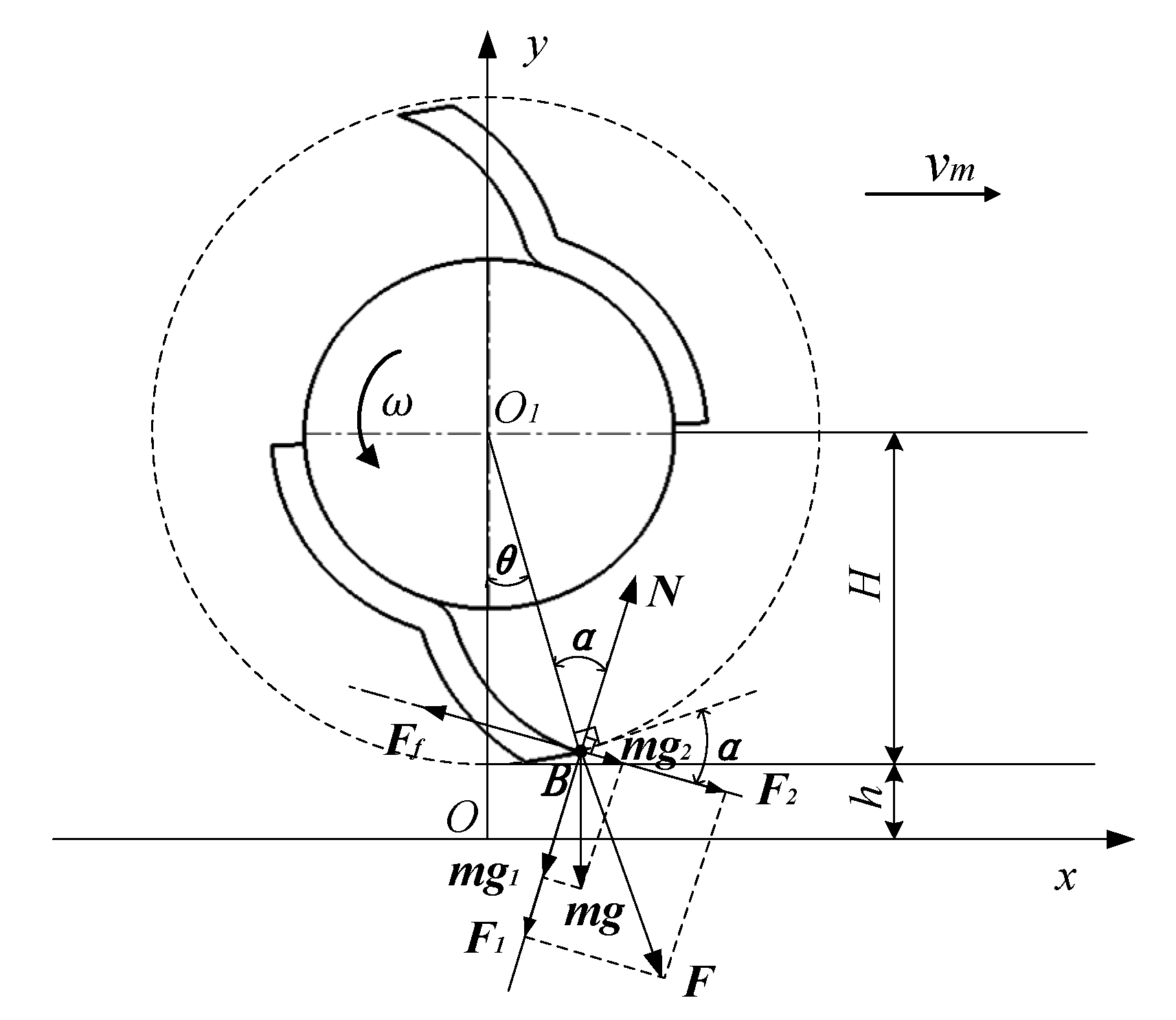


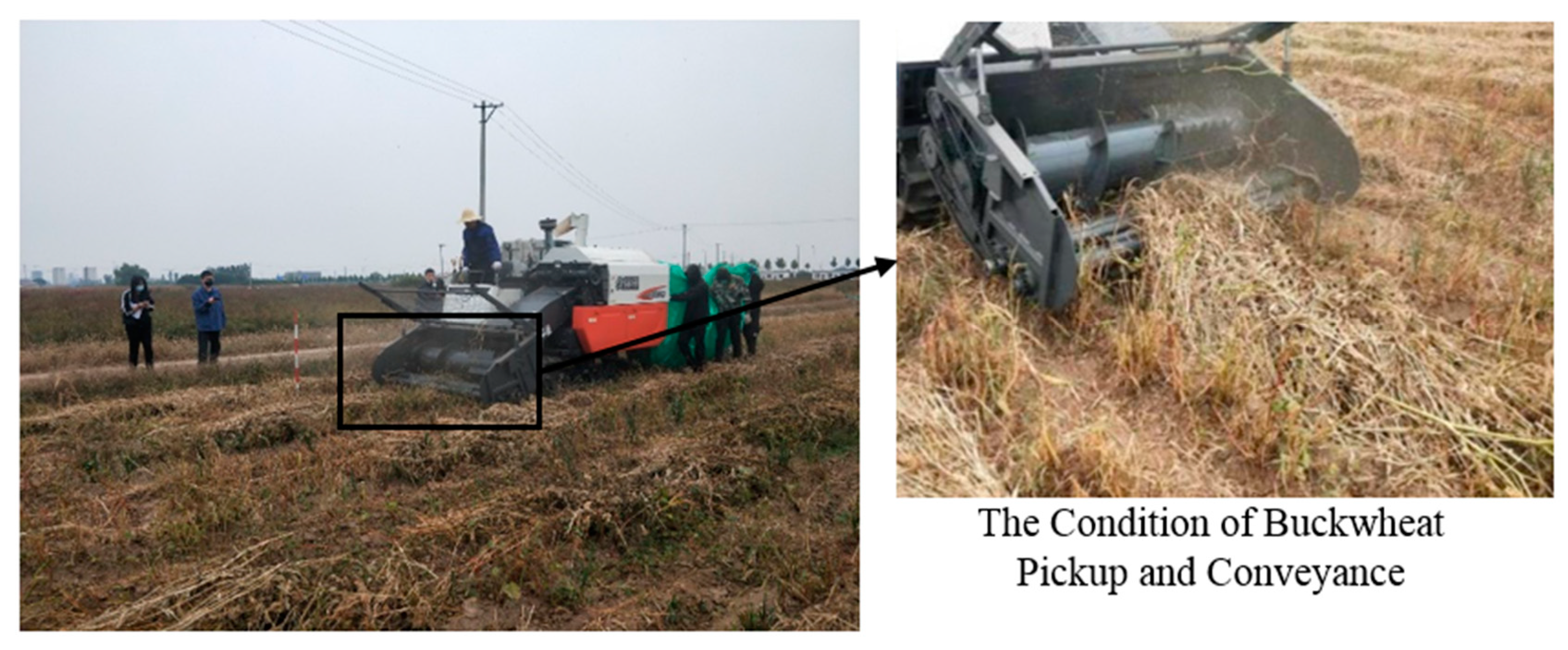

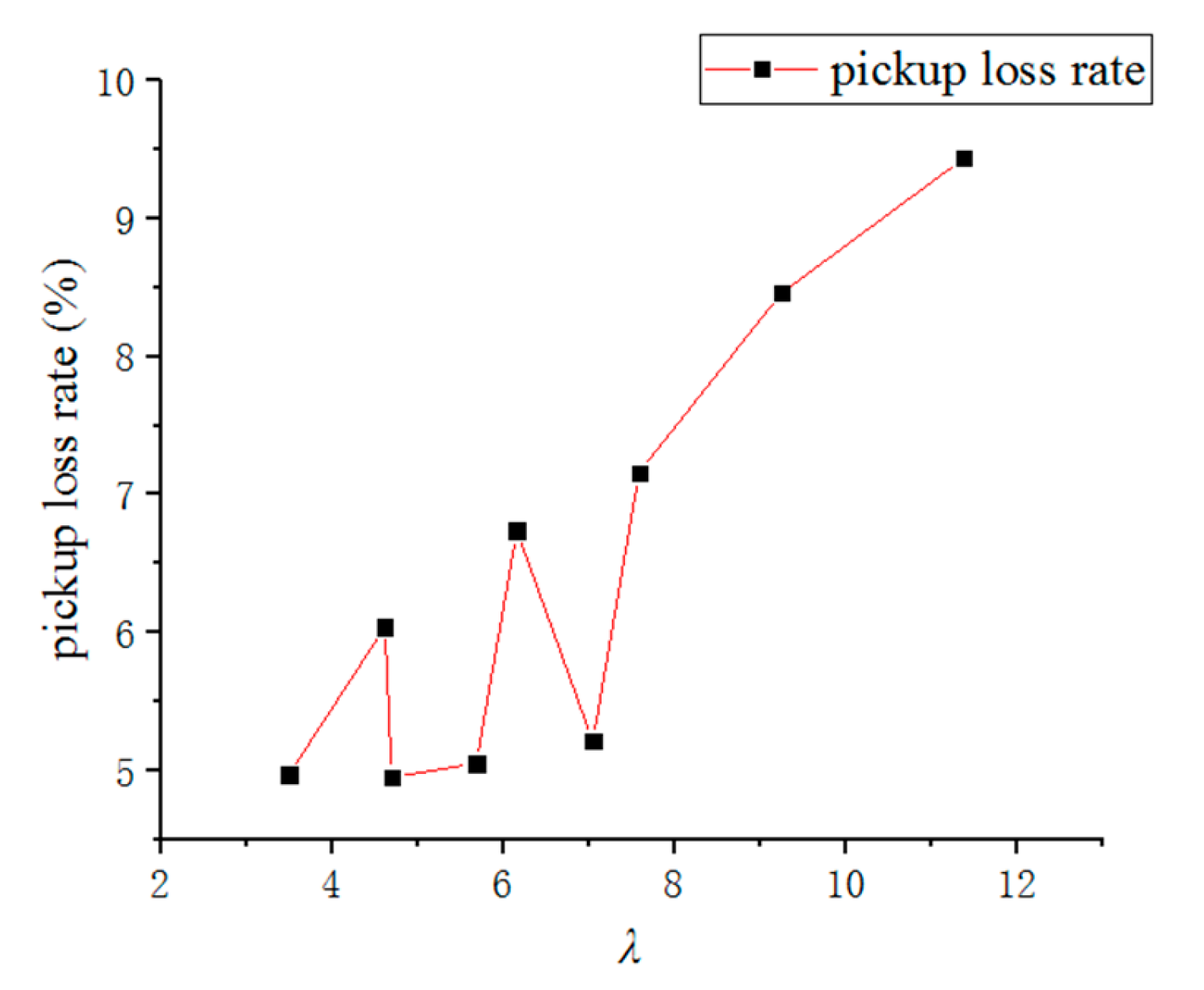
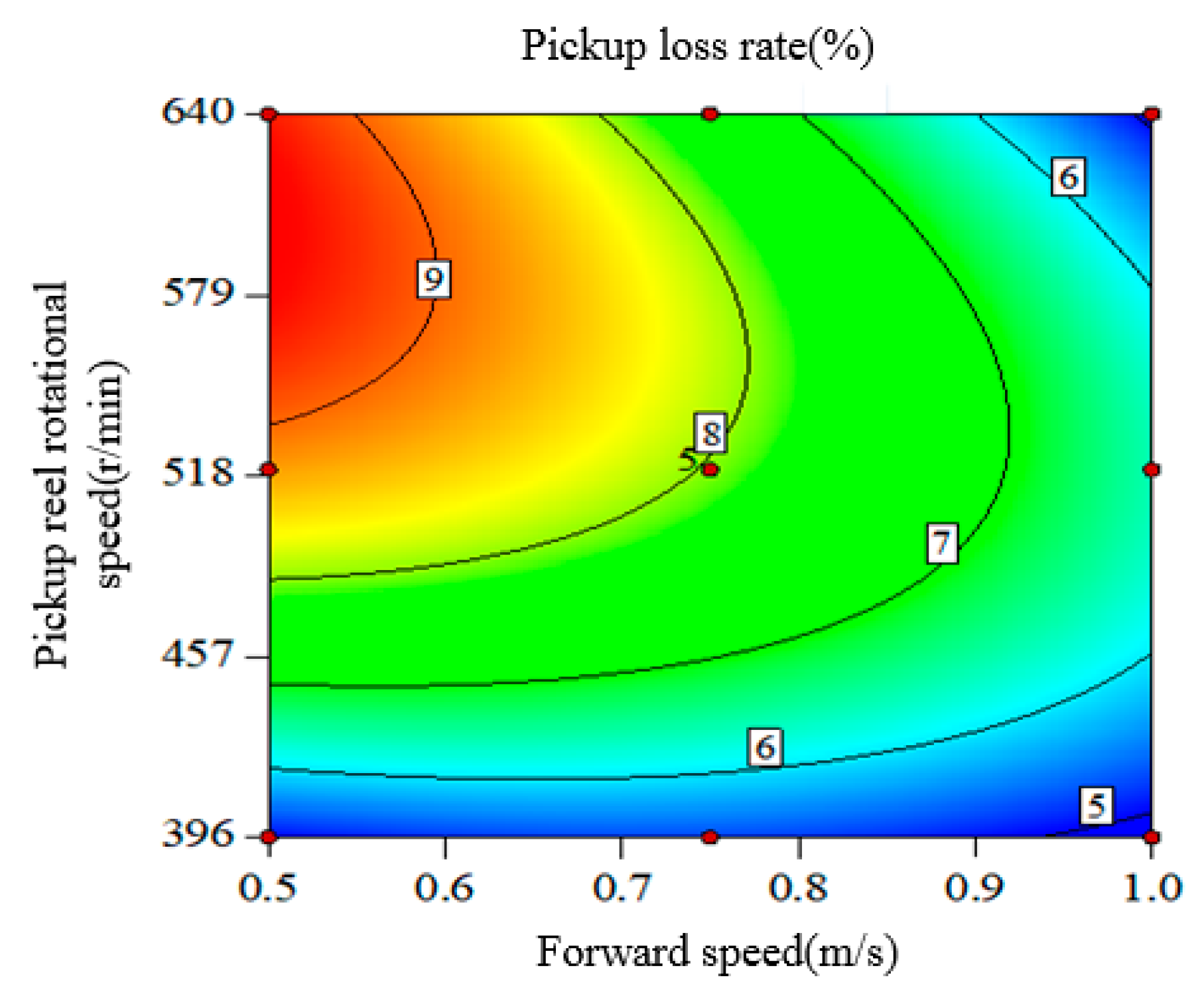
| Factor | Level | ||
|---|---|---|---|
| −1 | 0 | 1 | |
| A—Forward Speed/(m/s) | 0.50 | 0.75 | 1.00 |
| B—Pickup Roller Rotational Speed/(r/min) | 396 | 520 | 640 |
| Run | A—Forward Speed (m/s) | B—Pickup Roller Rotational Speed (r/min) | Speed Ratio λ | Pickup Loss Rate (%) |
|---|---|---|---|---|
| 1 | 0.50 | 640 | 11.39 | 9.44 |
| 2 | 0.75 | 640 | 7.59 | 7.16 |
| 3 | 1.00 | 640 | 5.69 | 5.05 |
| 4 | 0.5 | 520 | 9.25 | 8.46 |
| 5 | 0.75 | 520 | 6.16 | 8.17 |
| 6 | 1.00 | 520 | 4.62 | 6.04 |
| 7 | 0.5 | 396 | 7.05 | 5.21 |
| 8 | 0.75 | 396 | 4.70 | 4.95 |
| 9 | 1.00 | 396 | 3.50 | 4.97 |
| 10 | 0.75 | 520 | 6.16 | 7.74 |
| 11 | 0.75 | 520 | 6.16 | 8.51 |
| 12 | 0.75 | 520 | 6.16 | 8.23 |
| 13 | 0.75 | 520 | 6.16 | 7.80 |
| Source | Sum of Squares | DF | Mean Square | F-Value | p-Value | Significance |
|---|---|---|---|---|---|---|
| Model | 29.63 | 5 | 5.93 | 39.99 | <0.0001 | ** |
| A | 8.20 | 1 | 8.20 | 55.36 | 0.0001 | ** |
| B | 7.09 | 1 | 7.09 | 47.81 | 0.0002 | ** |
| AB | 4.31 | 1 | 4.31 | 29.07 | 0.0010 | ** |
| A2 | 0.40 | 1 | 0.40 | 2.69 | 0.1448 | |
| B2 | 6.70 | 1 | 6.70 | 45.2 | 0.0003 | ** |
| Residual | 1.04 | 7 | 0.15 | |||
| Lack of Fit | 0.63 | 3 | 0.21 | 2.05 | 0.2498 | |
| Pure Error | 0.41 | 4 | 0.10 | |||
| Cor Total | 30.67 | 12 | ||||
| R2 = 0.9662, Adj R2 = 0.9420, Pre R2 = 0.8403 | ||||||
Disclaimer/Publisher’s Note: The statements, opinions and data contained in all publications are solely those of the individual author(s) and contributor(s) and not of MDPI and/or the editor(s). MDPI and/or the editor(s) disclaim responsibility for any injury to people or property resulting from any ideas, methods, instructions or products referred to in the content. |
© 2024 by the authors. Licensee MDPI, Basel, Switzerland. This article is an open access article distributed under the terms and conditions of the Creative Commons Attribution (CC BY) license (https://creativecommons.org/licenses/by/4.0/).
Share and Cite
Ye, S.; Wang, X.; Zhang, C.; Zhang, J.; Wang, J.; Zheng, D. Design and Experiments of a Roll-Knife Pickup for a Buckwheat Pickup Harvester. Agronomy 2024, 14, 1944. https://doi.org/10.3390/agronomy14091944
Ye S, Wang X, Zhang C, Zhang J, Wang J, Zheng D. Design and Experiments of a Roll-Knife Pickup for a Buckwheat Pickup Harvester. Agronomy. 2024; 14(9):1944. https://doi.org/10.3390/agronomy14091944
Chicago/Turabian StyleYe, Shaobo, Xiaolei Wang, Chao Zhang, Jianlong Zhang, Jiawei Wang, and Decong Zheng. 2024. "Design and Experiments of a Roll-Knife Pickup for a Buckwheat Pickup Harvester" Agronomy 14, no. 9: 1944. https://doi.org/10.3390/agronomy14091944





